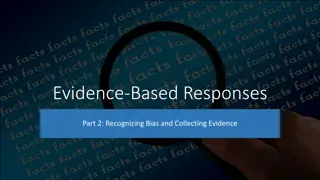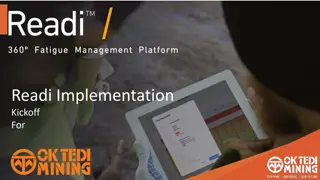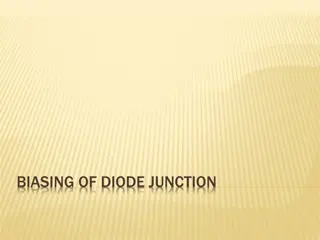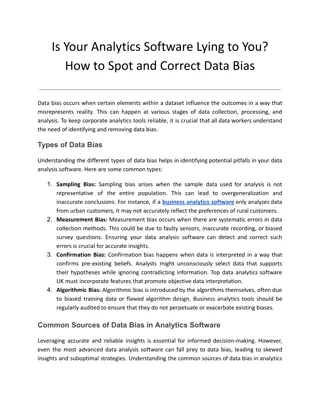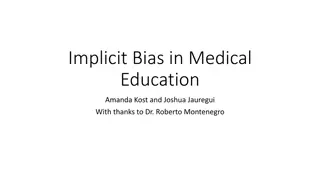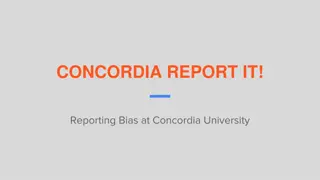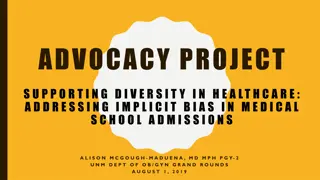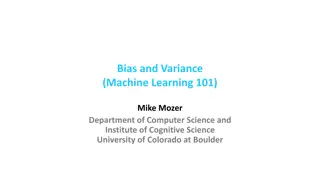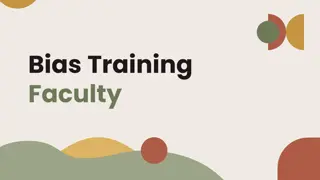REDI Deep Dives: Bias Busters Activity
Engage your team in activities to uncover implicit biases and promote equity and inclusivity. This slideshow resource guides participants through reflection and discussions on bias impact on decision-making. Learn how to recognize and address biases within a group setting for a more resilient and inclusive team culture. Customize the activities to suit your needs and foster learning at your own pace.
Download Presentation

Please find below an Image/Link to download the presentation.
The content on the website is provided AS IS for your information and personal use only. It may not be sold, licensed, or shared on other websites without obtaining consent from the author. Download presentation by click this link. If you encounter any issues during the download, it is possible that the publisher has removed the file from their server.
E N D
Presentation Transcript
REDI Deep Dives: Bias Busters
Welcome Thank you for your interest in engaging with this REDI resource. If you decide to use this resource, could you please fill out this form? (https://tinyurl.com/ubcredi) Let us know what unit at UBC you are from and any feedback you may have. This will help us understand how our resources are being used and ensure that we are meeting the needs of the community. If there are other similar types resources you would like to see, please let us know in the form, too. Thanks, REDI Team
Introduction to the activity This slide deck guides its audience through a series of activities, with the goal of helping participants become more aware of their implicit biases. By engaging in this work in a group setting with your team, we hope that this will help your team keep each other accountable to work together to create bias resilient process.
How this activity can benefit your team Implicit biases are invisible to us, but they can be uncovered. By being more aware of our implicit biases, we can become more aware of potentially biased behaviors that we exhibit and take steps to behave in more equitable and inclusive ways. It is especially important to be aware of the potential influence of implicit biases on our decision-making processes, in both personal decisions and decisions that we make as a team, as they affect the lives of students, colleagues, applicants, patients, and more.
A REDI Activity: A team discussion on implicit biases actions to remedy the impacts of bias on decision-making
Flexible learning approach These activities and this slideshow are designed to allow for flexibility. Feel free to tailor it according to your needs, available resources, and constraints. For example: You could show the slideshow in a meeting and do the activities all in one sitting. Or, you could have individuals do some of the work as a pre-session homework activity. You could also choose to copy/paste the activities and links and send them in bite-size pieces via email over a longer timeframe. You could have small discussions in pairs, or in groups of 4's or just provide time for individuals to reflect and then discuss. You can shuffle the groups part way through the activity.
Overview of the facilitation Pre-session Show/share the video, "Peanut Butter, Jelly, and Implicit Bias" Ask the audience to complete one of the three activities in which they take inventory of their experiences As a group - Engage the audience to complete the reflection activity Provide the resources on the final slide for more information and engage them in a discussion if you feel that would be appropriate
Objectives By the end of this activity, you will be able to... 1. Define implicit bias 2. Critically examine your own implicit biases 3. Reflect on how implicit bias may affect your work within your role 4. Practice strategies individually and as a group to self- correct for implicit biases
Peanut Butter Jelly and Implicit Bias Watch: https://www.pbs.org/ video/pov-implicit-bias- peanut-butter-jelly-and- racism/
1. Take inventory-Consider the books you read, the music you listen to, the movies you watch.... 1.Do they include main characters, creators, or artists that are from historically marginalized groups? Do ONE of the following: 2. Reflect- Think about your experiences in your professional role (eg. in adjudicating student assignments, treating patients, taking histories or hiring staff) or personal lives, what contextual factors are more likely to lead you to allow implicit biases to affect your decision-making or behaviour?
What did this experience reveal? What did you learn about yourself from taking inventory or taking an implicit bias test? Think about your role--either as faculty, clinical faculty, clinician, student, or other role--and the impacts of your decisions in that role. How might you modify your processes or environment so that you are less likely to let implicit biases affect your decisions? For example, in hiring decisions (see 2:32- https://www.youtube.com/watch?v=dVp9Z5k0dEE&t =20s) What are you doing to create counter-examples of stereotypes in the music you listen to, the books you read, the shows you watch to help shift these biases.... Consider this video clip: - https://www.ted.com/talks/chimamanda_ngozi_adichie_the_danger_of_a_sin gle_story Reflect and discuss Discuss with your colleagues- In what areas in our roles might bias negatively impact fair decision-making? What ideas do you have for ways we can counteract the influence of implicit biases in our roles?
1. Diversify your music, novels, comedians...so that you are learning from and learning about the experiences of people from historically marginalized groups. You are also creating counter-examples of stereotypes... 2. Strive for slower, more mindful decision-making if you can eg. Hiring, adjudication decisions so that you are specifically talking about criteria and not letting your biases affect decisions. Keep each other accountable and follow the rubrics. Don't let our assumptions about individuals or biases we hold influence decisions 3. Critically examine your own behaviour - In workplace decision-making, develop a habit of asking yourself the question "wait, would I have dealt with this person in the same way if this person looked X, Y, Z? Is that an unfair bias?" 4. Work as a team to create bias-resilient process Use this discussion as a starting point to identify key areas that might be important for your group and pick one and work to improve the process. 5. What are other actions that your team/individuals can implement? Some steps you can take:



